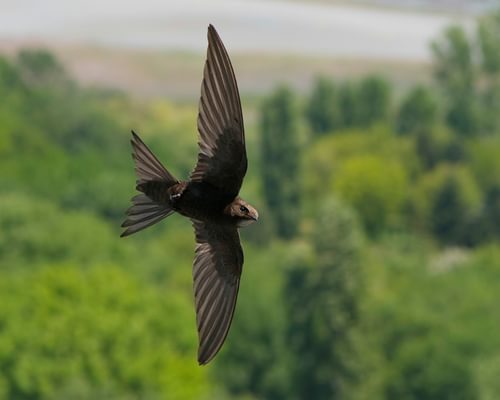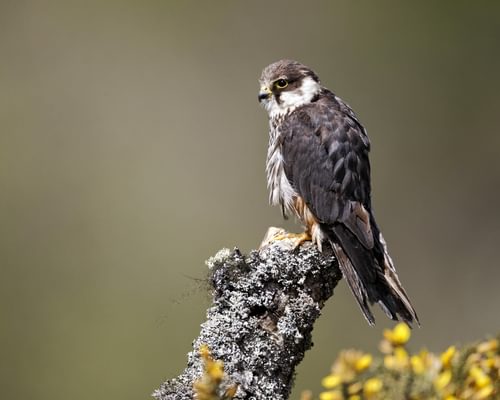Alpine Swift
Least ConcernTachymarptis melba
Visual Identification
Appearance
The Alpine Swift is characterised by its large size among swifts, with a sleek, streamlined body. Its upperparts are a uniform dark brown, contrasting sharply with a white belly and throat, separated by a brown breast band. Their long, narrow, and sickle-shaped wings are perfectly adapted for sustained flight.
Both sexes are similar in appearance, with juveniles closely resembling adults but showing slightly paler feather edges. The bird maintains this plumage year-round, with no significant seasonal variations.
Size
Length
20cm to 23cm
Wingspan
54cm to 60cm
Weight
76g to 120g
Colours
Males and females have similar plumage
Primary Colour
Brown White
Secondary Colour
Black
Beak Colour
Black
Leg Colour
Black
Habitat and Distribution
Habitats
Woodland
Garden
Wetland
Coastal
Urban
Farmland
Grassland
Desert
Tundra
Rainforest
Mountain
Savanna
Distribution
Alpine Swifts inhabit many environments, from high mountain cliffs to lowland areas and urban settings. They are found across southern Europe, parts of Asia, and Africa. Their breeding range extends from the Mediterranean to the Himalayas.
During winter, these birds migrate to sub-Saharan Africa and parts of southern Asia. They are occasional visitors in the UK, most often spotted along the south coast during spring and autumn migrations.
Elevation Range
Up to 2,800 meters
Climate zones
Temperate, Mediterranean, Subtropical
Distribution Map
This map gives you a rough idea of where you might spot a Alpine Swift. The coloured areas show countries where these birds have been seen.
A few things to keep in mind:
- Birds might not be everywhere in the coloured areas, for example, they may be present around the coast of that country
- Where birds live can change with seasons and available food
- This map is quite simple - it doesn't show exact locations
We're working on making our maps even better! Soon, we hope to show you:
- More detailed maps for bigger countries, including state and region
- How birds move around during different seasons
Distribution by Region
Behaviour and Ecology
Bird Attributes
This feature is in beta. We'd love your feedback to improve it!
Share your thoughtsBird Attributes Explained
Our bird attributes system rates various aspects of a bird's capabilities on a scale of 0-100, based on data from field observations, scientific studies, and expert knowledge.
Attribute Categories:
- Agility: Manoeuvrability, speed, and grace in flight or movement.
- Strength: Physical power, often correlating with size and hunting abilities.
- Adaptability: Ability to thrive in various environments or changing conditions.
- Aggressiveness: Territorial behaviour and assertiveness, particularly during breeding seasons.
- Endurance: Stamina, often seen in migration patterns or foraging behaviours.
Understanding the Ratings:
- 0-20: Very Low
- 21-40: Low
- 41-60: Average
- 61-80: High
- 81-100: Very High
Remember, these attributes are relative to other bird species and don't necessarily indicate superiority.
Hover over the icon next to each attribute for more information.
Tap the icon next to each attribute for more information.
Agility
Reflects the bird's manoeuvrability, speed, and grace in flight or movement.
The Alpine Swift possesses extraordinary agility, capable of intricate aerial manoeuvres and staying airborne for months. Its sickle-shaped wings and streamlined body enable remarkable manoeuvrability at high speeds, making it one of the most agile birds in flight.
Strength
Indicates the bird's physical power, often correlating with size and hunting abilities.
While not exceptionally strong in terms of raw power, the Alpine Swift has considerable strength relative to its size. Its ability to maintain flight for extended periods and reach speeds of up to 220 km/h during dives indicates significant muscular endurance and power.
Adaptability
Represents the bird's ability to thrive in various environments or changing conditions.
Highly adaptable, the Alpine Swift thrives in diverse environments from high mountain cliffs to urban settings. Its ability to feed, drink, and even sleep on the wing demonstrates remarkable adaptability to an aerial lifestyle, though it's somewhat specialised in its nesting requirements.
Aggressiveness
Measures the bird's territorial behaviour and assertiveness, particularly during breeding seasons.
Alpine Swifts are not particularly aggressive birds. They are highly social, often seen in large flocks, and show no notable territorial aggression outside of defending nesting sites. Their screaming calls might seem aggressive but are primarily for communication.
Endurance
Reflects the bird's stamina, often seen in migration patterns or foraging behaviours.
The endurance of the Alpine Swift is truly exceptional. Its ability to stay airborne for up to 200 days without landing, coupled with long-distance migrations and constant aerial activity, places it among the most enduring bird species known.
Diet
Alpine Swifts are insectivores, feeding exclusively on flying insects and airborne spiders caught in flight. They have a particular preference for flying ants and beetles.
These birds can travel great distances to find food, often feeding at high altitudes where insects are carried by updrafts.
Behaviour
Alpine Swifts are supremely adapted for an aerial lifestyle and can stay aloft for incredibly long periods. They feed, drink, and even sleep on the wing, rarely landing except to nest.
These birds are highly social, often seen in large, screaming flocks, particularly during migration and in feeding areas.
Vocalisation
The Alpine Swift's call is a loud, piercing scream, often described as a shrill 'sree-sree-sree'. These vocalisations are frequently heard in flight, especially when birds are in groups.
During the breeding season, they produce a softer, more musical twittering sound near nesting sites.
Nesting & Breeding
Alpine Swifts typically form monogamous pairs, breeding from May to August. They often return to the same nesting sites year after year, showing strong site fidelity.
Nests are built in crevices on cliff faces or on tall buildings in urban areas. The nest is a shallow cup comprising of feathers, plant material, and saliva. Females usually lay 2-4 white eggs.
Both parents share incubation duties for about 18-23 days. Chicks fledge after 53-66 days, one of the longest fledging periods among small birds, reflecting their highly aerial lifestyle.
Lifespan
The Alpine Swift typically lives for 10 to 15 years, with a maximum recorded lifespan of 26 years.
Like all birds, lifespan can be affected by factors including predation, habitat quality, disease, and access to food sources.
Conservation and Status
Global Conservation Status
While the Alpine Swift is currently listed as Least Concern, it faces threats from climate change affecting its mountain habitats. Urban development can provide nesting sites on buildings and pose risks through collisions.
Conservation efforts focus on protecting natural nesting sites and creating safe urban habitats.
Birdwatching Tips
- Look for them soaring at great heights, especially near cliffs or tall buildings
- Listen for their distinctive, high-pitched screaming calls
- Observe their characteristic 'flashing' appearance as they alternately show their dark backs and white bellies during flight
- In the UK, watch for them as rare but regular visitors, especially along the south coast
Additional Information
Quick Facts
Other names:
White-bellied Swift
Family:
ApodidaePredators
Did You Know?
- Alpine Swifts can stay airborne for up to 200 days without landing.
- They can reach speeds of up to 220 km/h during aerial dives.
- These birds have been recorded flying at altitudes of over 4,000 meters.
- The Alpine swift comes from the family Apodidae, which is ancient Greek for ‘without feet’, because these birds have extremely short legs and small feet, which are almost impossible to see when the bird is in flight.
Was this bird profile helpful?
Your feedback helps us improve our content
Thanks for your feedback!
Your input helps us improve our content.
Community Experience
Community Ratings
No ratings yet - be the first to rate this bird!
Latest Community Reviews
No reviews yet
Sign in to be the first to review
Community Reviews
Create Your Free Account Welcome Back!
Join our community to rate birds and share your experiences. Creating an account is completely free and only takes a minute. Sign in to your account to rate birds and share your experiences with our community.
Your information is secure and will never be shared.
By creating an account, you agree to our Privacy Policy.
Similar Birds
References
- 2 3 4
website: BirdLife International. 2016. Tachymarptis melba. The IUCN Red List of Threatened Species 2016: e.T22686774A86109107.
View source - 1
journalArticle, 2006: Moller, Sociality, age at first reproduction and senescence: comparative analyses of birds, J Evol Biol, 19:682-689
View source

